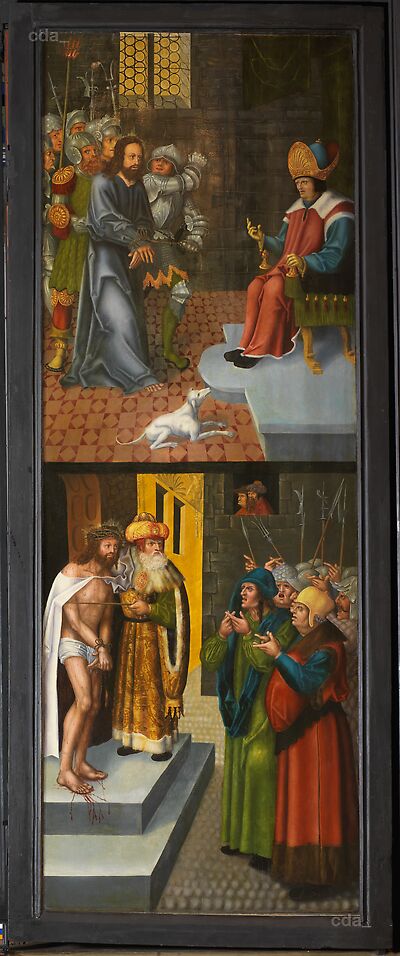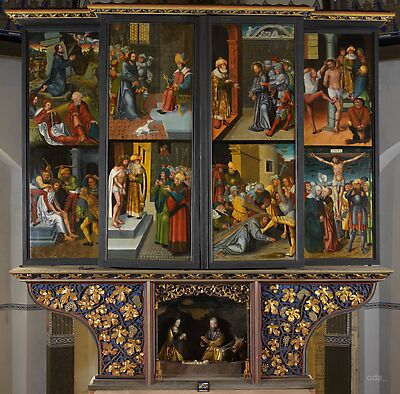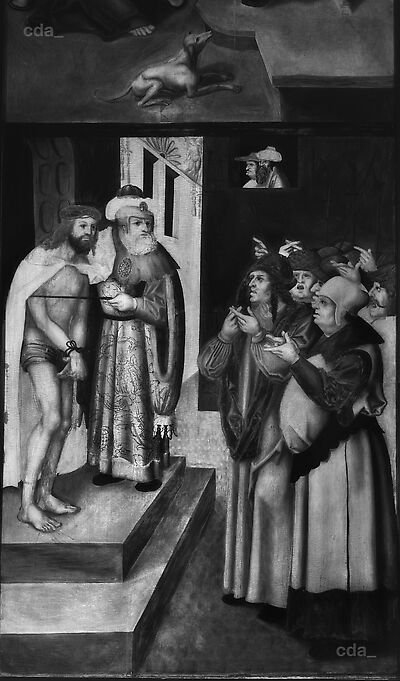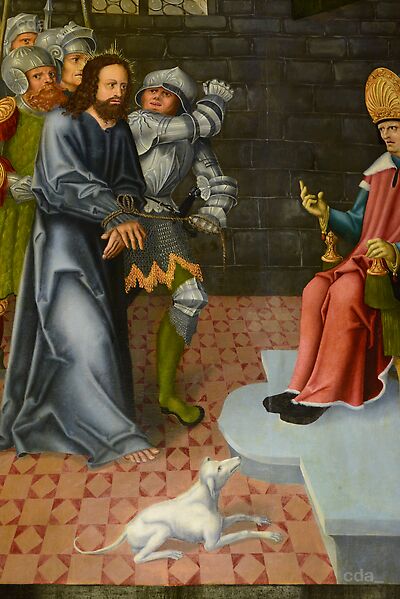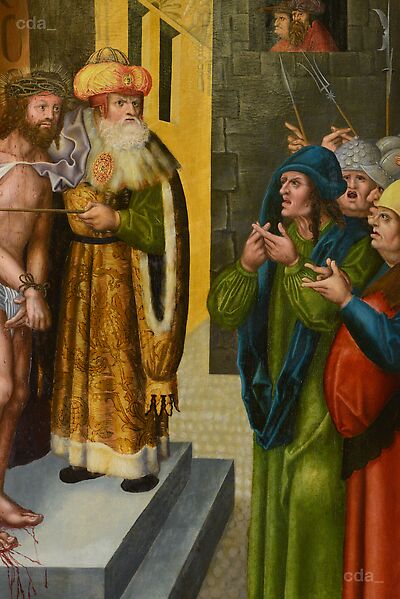The outer wing panels of the altar depict Christ's passion, while the inner wing panels (the 1st transformation) illustrate the Legend of St Nicolas. The shrine contains almost life-size wooden statues of various bishops, among them St Nicolas.
Like in Döbeln the church patron St Nicolas is the centre piece of
The outer wing panels of the altar depict Christ's passion, while the inner wing panels (the 1st transformation) illustrate the Legend of St Nicolas. The shrine contains almost life-size wooden statues of various bishops, among them St Nicolas.
Like in Döbeln the church patron St Nicolas is the centre piece of the open altar. Beside him rank Erasmus [...] and a bishop holding a book and a ciborium (?) (Donatus of Arezzo?). The wings of the shrine contain saints Barbara and Margaret on the left and on the right Christopher, the patient bearer of 'divine burden', and a saint whose attribute is now lost (Leonard?). The predella contains a relief representation of the Nativity with a painted scene of the Annunciation to the Shepherds in the background.
The St Nicolas series, which is the most complete version in Saxony, faithfully illustrates the stages of the saint's life. However some of the more popular miracles are missing.
This panel depicts (on the inner side):
- upper field: St Nicolas throws a lump of gold through a poor man's window to save his daughters from the shame of being sold to a brothel.
- lower field: St Nicolas is shown as the protector of seafaring pilgrims, who were given oil by a reputed pious woman to paint the walls of the church. The promised miraculous power was a swindle and the flaming barrels on the water serves as a warning against heathen practice.
on the exterior:
- upper field: Christ before Caiaphas
- lower field: Ecce Homo (or the Presentation of Christ)
[Sandner 1993, 146-148]
![The Former Highaltar the Church of St Nicolas, Grimma: St Nicolas donates gold; St Nicolas as Protector of Pilgrims [interior of outer left wing, 1st transformation]; Christ before Caiaphas; Ecce Homo [exterior of outer left wing, 2nd transformation]](https://lucascranach.org/imageserver-2022/DE_FKG_FKG001F_FR-none/01_Overall/DE_FKG_FKG001F_FR-none_2016-09_Overall-s.jpg)

![The Former Highaltar the Church of St Nicolas, Grimma: Nicolas is made bishop of Myra; The Miracle of the Man run over by a Wagon [left inner wing, 1st transformation]](https://lucascranach.org/imageserver-2022/DE_FKG_FKG001D_FR-none/01_Overall/DE_FKG_FKG001D_FR-none_2016-09_Overall-s.jpg)
![The Former Highaltar the Church of St Nicolas, Grimma: St Nicolas saves the Sailors from the Stormt; A Knight with his Horse before St Nicolas' Altarpiece [right inner wing, 1st transformation]](https://lucascranach.org/imageserver-2022/DE_FKG_FKG001E_FR-none/01_Overall/DE_FKG_FKG001E_FR-none_2016-09_Overall-s.jpg)
![The Former Highaltar the Church of St Nicolas, Grimma: the Miracle of the Wheat; The Miracle of the Golden Chalice [interior of outer right wing, 1st transformation]; Christ before Pilate; Christ carrying the Cross [exterior of outer right wing, 2nd transformation]](https://lucascranach.org/imageserver-2022/DE_FKG_FKG001G_FR-none/01_Overall/DE_FKG_FKG001G_FR-none_2016-09_Overall-s.jpg)
![The Former Highaltar the Church of St Nicolas, Grimma: The Arrest of Christ; The Mocking of Christ, [left fixed wing, 2nd transformation]](https://lucascranach.org/imageserver-2022/DE_FKG_FKG001H_FR-none/01_Overall/DE_FKG_FKG001H_FR-none_2016-09_Overall-s.jpg)
![The Former Highaltar the Church of St Nicolas, Grimma: The Flagellation; The Crucifixion, [right fixed wing, 2nd transformation]](https://lucascranach.org/imageserver-2022/DE_FKG_FKG001I_FR-none/01_Overall/DE_FKG_FKG001I_FR-none_2016-09_Overall-s.jpg)

